Beef Roast In The Oven
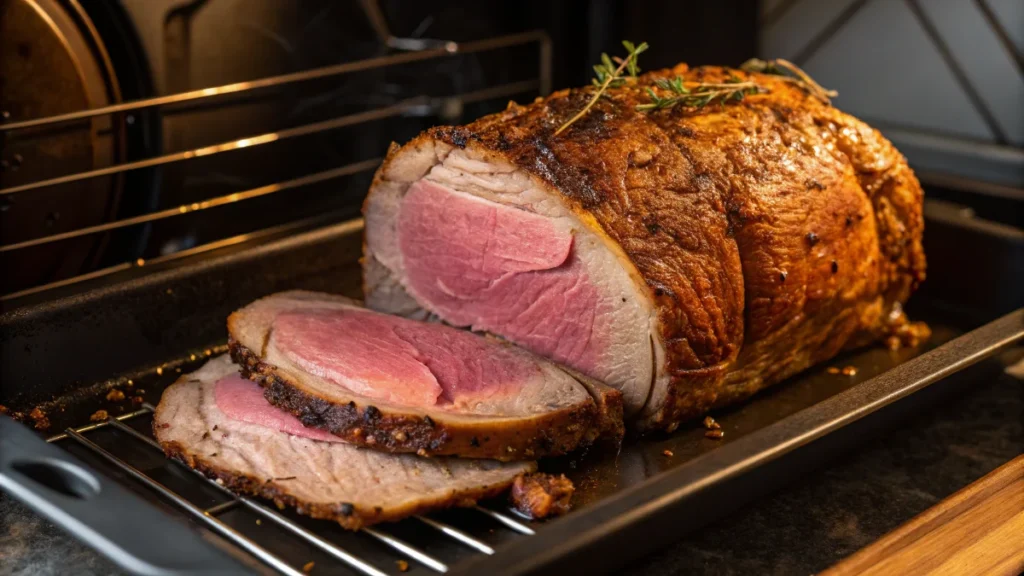
Nothing quite beats the comforting aroma of a beef roast in the oven wafting through the house. Whether it’s a Sunday family dinner or a special occasion, this classic dish never fails to impress. I remember the first time I perfected this recipe, it brought everyone to the table with eager anticipation. Cooking a beef roast in the oven is simpler than you might think, and the results are absolutely delicious.
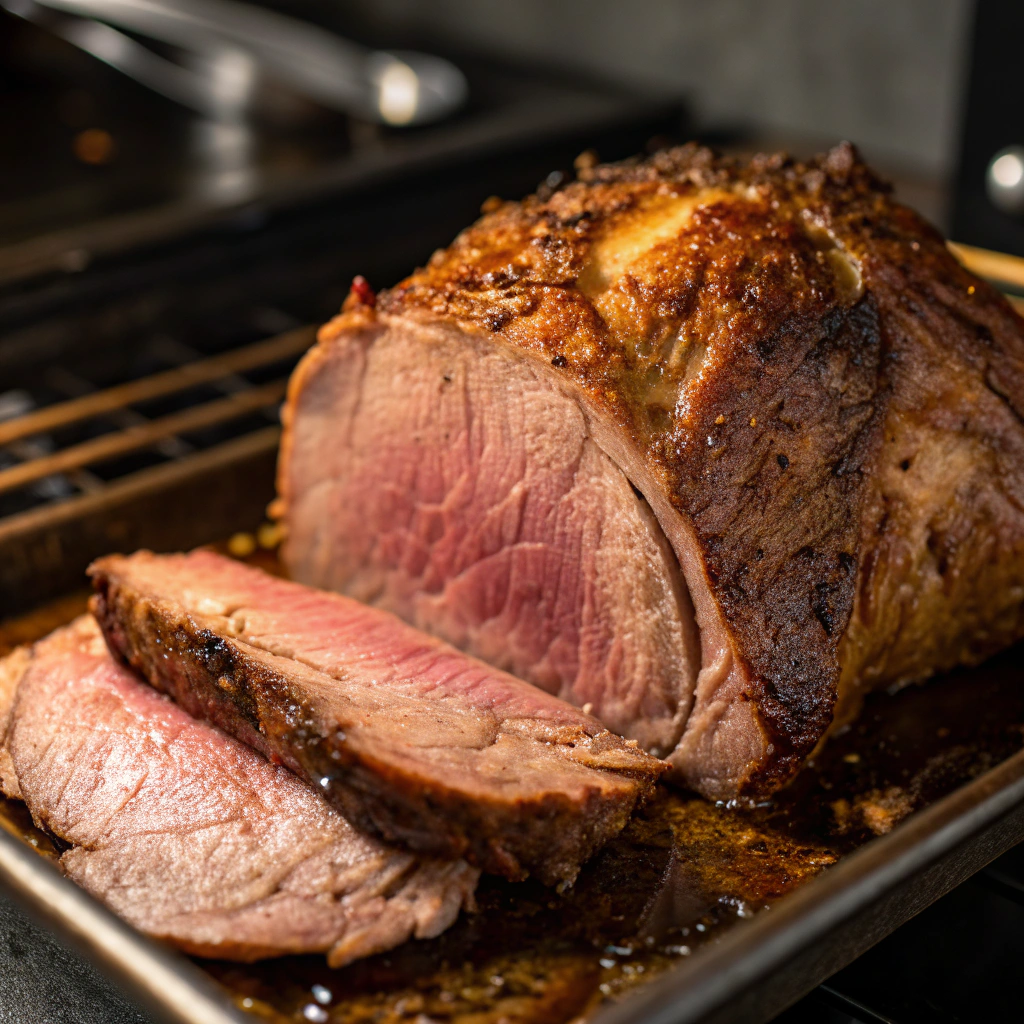
Let's dive into why this recipe is a must-try and how you can master the art of roasting beef in your own kitchen.
— ✦ —
Why This Beef Roast Recipe Deserves a Place in Your Culinary Repertoire?
This beef roast in the oven recipe is a delightful blend of simplicity and flavor. It caters to both those new to cooking and experienced culinary enthusiasts looking to create a hearty meal. The slow-roasting process ensures that the beef remains juicy and tender, infused with rich flavors from herbs and seasonings. Plus, it's incredibly versatile—ideal for pairing with a variety of sides, making it a favorite for any meal.
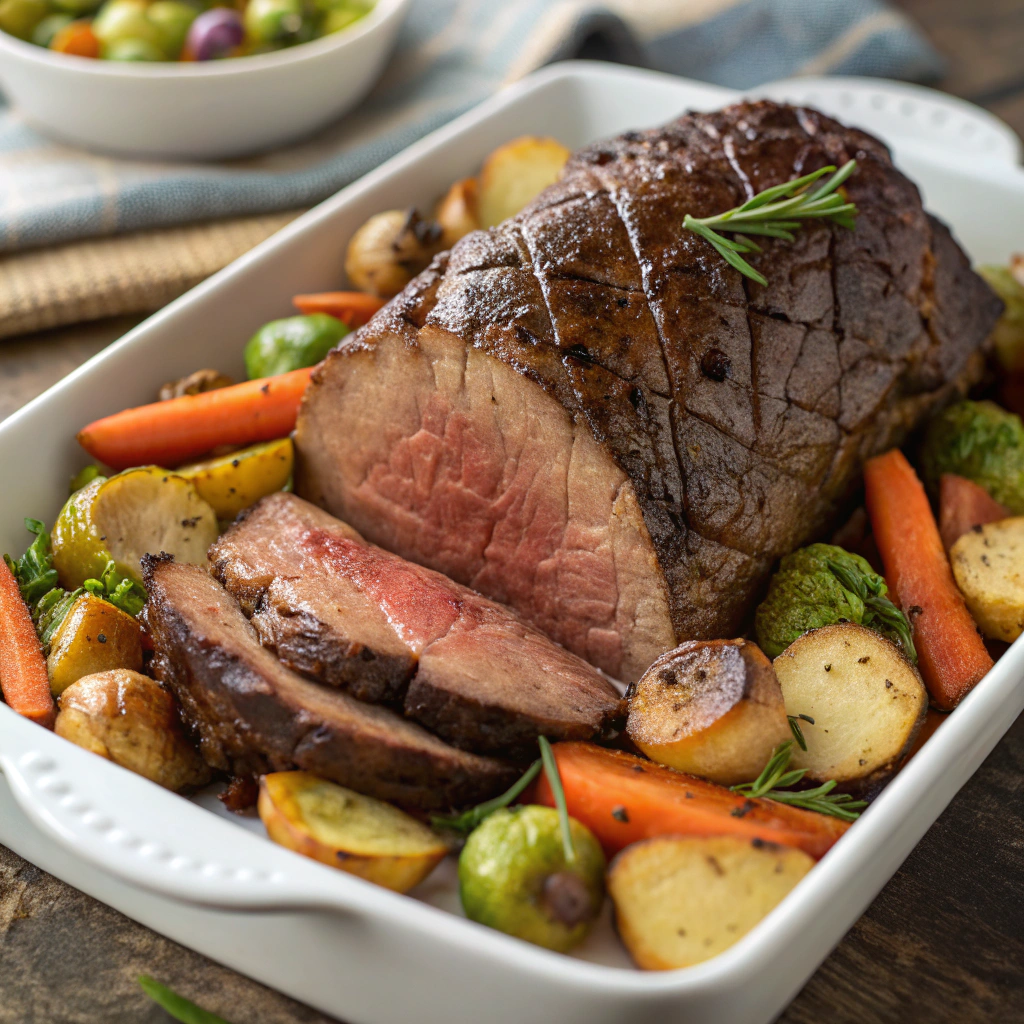
— ✦ —
Ingredients
- 3 lbs beef chuck roast
- 2 tablespoons olive oil
- 1 large onion, sliced
- 4 cloves garlic, minced
- 2 teaspoons salt
- 1 teaspoon black pepper
- 1 tablespoon rosemary, chopped
- 1 tablespoon thyme, chopped
- 2 cups beef broth
Alternatives
If you prefer, you can substitute beef chuck roast with rib-eye or sirloin for different flavor profiles. Moreover, you have the option to use vegetable broth in place of beef broth for a lighter taste.
— ✦ —
Step-by-Step Instructions
Preparing the Beef Roast
Begin by setting your oven to preheat at 325°F. While the oven warms up, prepare your beef roast by trimming any excess fat. This helps in achieving a leaner dish while allowing the seasoning to penetrate better. Rub the entire surface of the beef with olive oil, ensuring an even coating. This not only adds flavor but also helps in forming a beautiful crust during roasting.
Searing the Beef Roast in the Oven
Warm up a spacious, oven-friendly skillet on medium-high heat. Once hot, place the beef roast in the skillet and sear each side until it develops a deep, brown color. This step is crucial as it locks in the juices, keeping the beef tender and flavorful. Searing typically takes about 3-4 minutes per side.
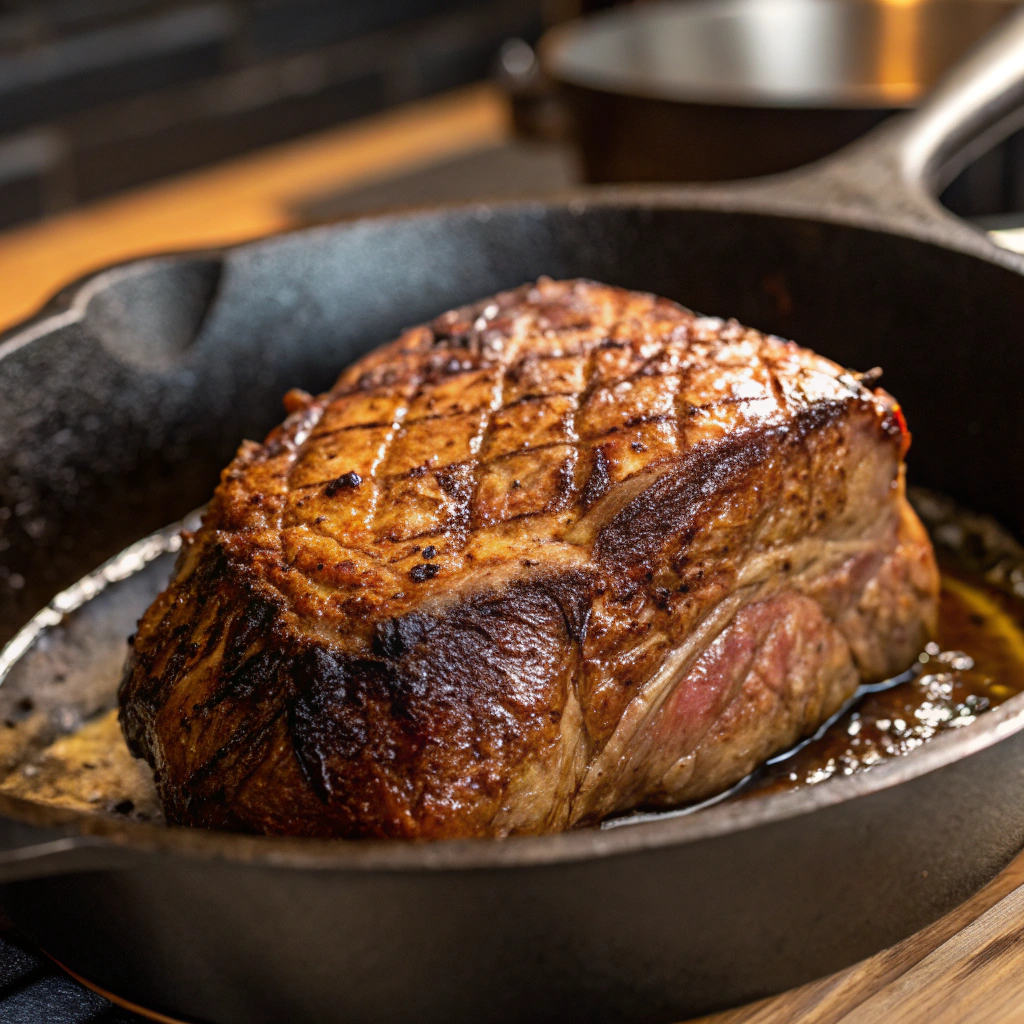
— ✦ —
Slow-Roasting the Beef Roast in the Oven
After searing, add the sliced onions and minced garlic around the beef roast. These aromatics will infuse the meat with wonderful flavors as it cooks. Pour in the beef broth, ensuring the roast is partially submerged in the liquid. Top the skillet with a lid or a sheet of aluminum foil and place it in the preheated oven. Slow-roast the beef for about 3 hours, or until it reaches the desired tenderness.
Monitoring the Roast's Internal Temperature in the Oven
Utilize a meat thermometer to gauge the roast's core temperature to ensure it has reached at least 145°F for medium doneness. This guarantees that the roast is cooked to perfection, maintaining its juiciness and tenderness. Be sure to measure the temperature at the meat's most substantial section for the most accurate reading.
Resting the Beef Roast After Cooking in the Oven
Once the beef roast is done, remove it from the oven and let it rest for at least 15 minutes. Resting permits the juices to settle evenly within the meat, leading to a juicier and tastier outcome roast. Lightly tent the roast with foil throughout this period to keep it warm.
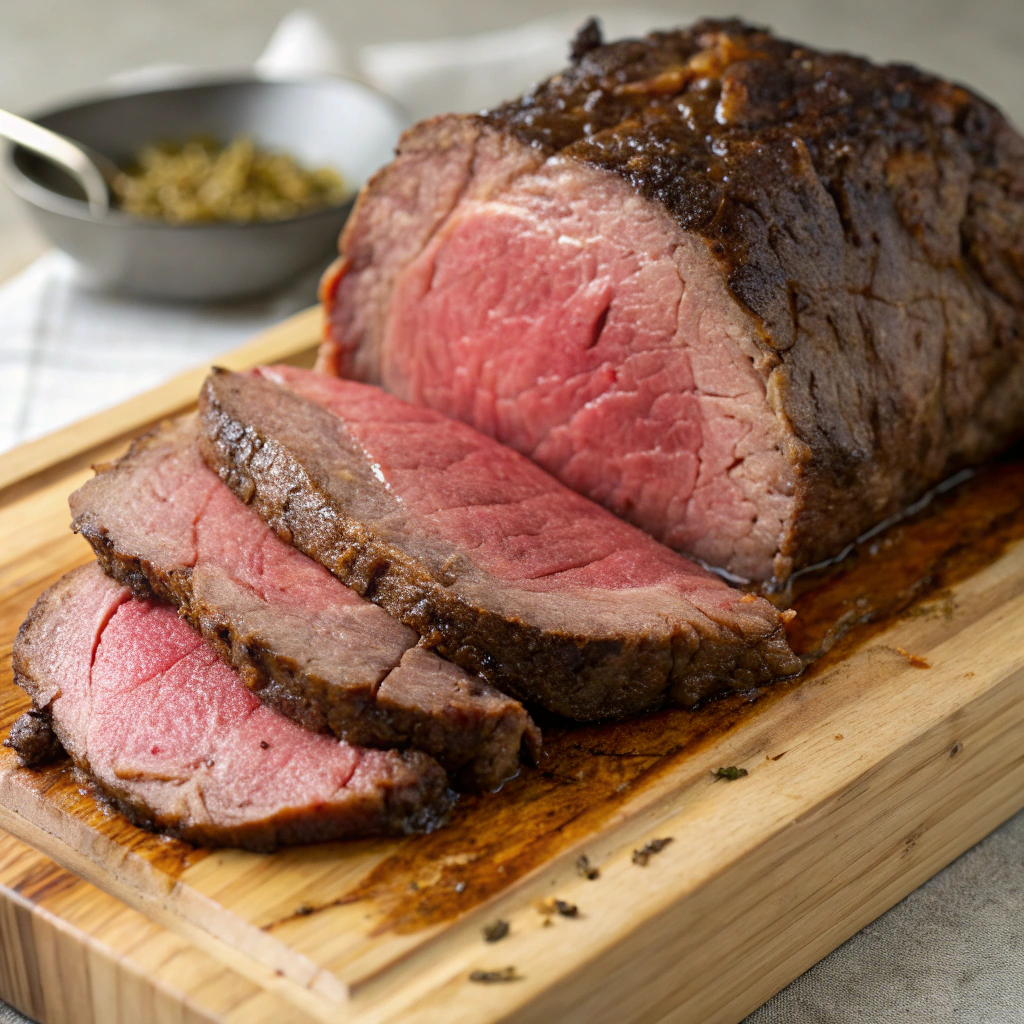
— ✦ —
Common Mistakes to Avoid
Overcooking the Beef Roast
One of the most common mistakes when cooking a beef roast in the oven is overcooking. Overcooked beef becomes tough and dry, losing its desirable texture. To avoid this, monitor the internal temperature closely and remove the roast from the oven as soon as it reaches the desired doneness.
Not Letting the Beef Roast Rest
Skipping the resting period is another frequent error. Without resting, the juices run out when you cut into the meat, leading to a less moist roast. Always allow your beef roast to rest before carving to ensure maximum juiciness.
Using the Wrong Cut for the Beef Roast in the Oven
Choosing the right cut is essential for a successful beef roast. Cuts like chuck roast, rib-eye, and sirloin are ideal because they have the right balance of fat and connective tissues, which disintegrate throughout slow roasting to create a tender dish.
Skipping the Searing Step
Searing the beef roast before roasting is a crucial step that enhances flavor and texture. Skipping this step can result in a less flavorful roast. Take the time to sear each side properly to develop a rich crust.
— ✦ —
Expert Tips & Tricks
Selecting the Best Beef Roast in the Oven
When selecting a beef roast, look for cuts with good marbling. The fat content not only adds taste while keeping the meat tender and hydrated during the cooking process. Chuck roast serves as an excellent choice for those new to roasting due to its balance of flavor and tenderness.
Enhancing Flavor with Marinades
Marinating your beef roast can significantly boost its flavor. A simple marinade with olive oil, garlic, herbs, and a splash of vinegar can infuse the meat with delicious aromas and tastes. Let the beef marinate overnight for the best results.
Achieving Perfect Doneness
To achieve perfect doneness, invest in a good meat thermometer. This tool ensures that your beef roast is cooked exactly how you like it, whether you prefer it medium-rare or well-done. Consistent temperature readings lead to consistently excellent roasts.
Making Gravy from Drippings
Don't waste the flavorful drippings left in the skillet after roasting. You can easily turn them into a delicious gravy by simmering the liquid with a bit of flour to thicken. This gravy complements the beef roast wonderfully and introduces an additional dimension of taste to your meal.
— ✦ —
Serving Suggestions
Pairing with Oven-Roasted Vegetables
Oven-roasted vegetables like carrots, potatoes, and Brussels sprouts make the perfect side for a beef roast. Their inherent sweetness enhances the rich, savory notes of the beef, creating a balanced and satisfying meal.
Complementing with Mashed Potatoes
Smooth mashed potatoes make a timeless side dish to beef roast. The creamy consistency and rich buttery taste of the potatoes harmonize excellently with the hearty beef, making each bite a delight.
Adding a Fresh Salad
A fresh green salad adds a light and crunchy juxtaposition to the beef's richness roast. Consider a simple mix of greens, cherry tomatoes, and a tangy vinaigrette to brighten up the meal.
Presenting with a Rich Gravy
Finish your beef roast presentation with a generous pour of the homemade gravy. The savory sauce enhances the flavors of the meat and ties all the components of the meal together in a harmonious way.
— ✦ —
Recipe Troubleshooting
If your beef roast doesn’t turn out as expected, consider the following troubleshooting tips:
- If the roast is too tough, it might have been cooked too quickly. Ensure you use the slow-roasting method to break down the connective tissues.
- If the roast is dry, check the internal temperature earlier next time and make sure to let it rest properly before carving.
- If the seasoning is insufficient, adjust the herbs and spices in your marinade or rub to better suit your taste preferences.
— ✦ —
Storage Recommendations
Best Before Timeframe
Store any leftover beef roast in an airtight container in the refrigerator. It will stay fresh for a maximum of 4 days. To preserve it longer, consider freezing the roast for up to 3 months without compromising its quality.
Storing Techniques
To store your beef roast, allow it to reach room temperature prior to securely wrapping it in aluminum foil or placing it in a vacuum-sealed bag. Proper storage prevents freezer burn and maintains the roast’s flavor and texture.
— ✦ —
Variations
Herb-Crusted Beef Roast
Add a mixture of fresh herbs like rosemary, thyme, and parsley to the seasoning rub for an herbaceous twist. This version introduces an added depth of taste that complements the beef beautifully.
Garlic and Rosemary Beef Roast
Enhance the classic beef roast with an abundance of garlic and rosemary. These flavors infuse deeply into the meat, providing a fragrant and savory profile that’s hard to resist.
Spicy Beef Roast in the Oven
If you like a bit of heat, incorporate spices like cayenne pepper, paprika, and chili flakes into your seasoning mix. This spicy variation adds a bold kick to the traditional beef roast.
Honey-Glazed Beef Roast
For a touch of sweetness, brush a honey glaze over the beef roast during the last hour of cooking. The honey caramelizes, creating a deliciously sticky and sweet exterior that pairs wonderfully with the savory meat.
— ✦ —
Selecting the Perfect Beef Roast in the Oven
Choosing the Right Cut for Your Beef Roast in the Oven
Selecting the appropriate cut is crucial for a successful roast. Cuts like chuck, rib-eye, and sirloin are top choices for their flavor and tenderness. Each cut offers a different texture and taste, therefore, select one that matches the flavors you enjoy and cooking expertise.
Understanding Beef Grades
Beef classifications depend on their quality, including Prime, Choice, and Select being the most common grades. Prime offers the highest level of marbling and tenderness, making it ideal for a flavorful roast. Choice is a bit leaner but still delivers excellent results, while Select is best for those who prefer a leaner cut.
Sizing Your Beef Roast for the Oven
The size of your beef roast depends on the number of servings you need. A 3-pound roast typically serves 6-8 people. Ensure your oven can accommodate the size of the roast, allowing enough space for even cooking and airflow.
Preparing Your Beef Roast for Cooking in the Oven
Preparation is key to a perfect roast. Trim excess fat, season generously with your chosen herbs and spices, and let the roast come to room temperature before placing it in the oven. Proper preparation ensures even cooking and maximum flavor infusion.
— ✦ —
Enhancing the Flavor of Your Beef Roast in the Oven
Marinating Your Beef Roast in the Oven
Marinating adds depth to the beef's flavor. Combine olive oil, minced garlic, fresh herbs, and a splash of vinegar. Let the beef marinate for at least 4 hours, preferably overnight, to allow the flavors to permeate the meat thoroughly.
Using Herbs and Spices in Your Beef Roast
Herbs like rosemary, thyme, and oregano elevate the beef's natural flavors. Additionally, spices such as black pepper, paprika, and garlic powder add complexity. Create a balanced seasoning blend that enhances without overpowering the beef.
Incorporating Vegetables with Your Beef Roast in the Oven
Adding vegetables like carrots, onions, and potatoes to the roasting pan not only provides delicious side dishes but also enriches the roast with their natural sweetness and flavors. The vegetables absorb the beef drippings, becoming tender and flavorful.
Creating a Gravy from Your Beef Roast Drippings
Transform the drippings left in the roasting pan into a luxurious gravy. Skim off excess fat, then simmer the drippings with a bit of flour to thicken. For added richness, incorporate a splash of beef broth, and season to taste.
— ✦ —
Perfecting the Cooking Process for Your Beef Roast in the Oven
Achieving Ideal Internal Temperature for Your Beef Roast in the Oven
Keeping the proper internal temperature is crucial for a perfectly cooked roast. Employ a dependable meat thermometer to track the temperature, aiming for 145°F for medium doneness. Adjust the cooking time based on the roast's size and desired level of doneness.
Timing Your Beef Roast
Timing is crucial in roasting beef. As a general rule, roast the beef for approximately 20 minutes per pound at 325°F. However, always rely on the internal temperature rather than time alone to determine when the roast is done.
Letting Your Beef Roast in the Oven Rest Before Carving
Allowing your roast to rest after cooking helps retain its juices, making each slice tender and moist. Gently tent the roast with foil and allow it to rest for at least 15 minutes before carving. This step cannot be skipped for the best results.
Adjusting Cooking Techniques for Different Cuts
Different cuts of beef may require slight adjustments in cooking techniques. For example, leaner cuts like sirloin might benefit from higher temperatures for a shorter time to prevent drying out, while fattier cuts like chuck roast thrive with lower temperatures and longer cooking times to break down the connective tissues.
— ✦ —
Wrap-Up
Cooking a beef roast in the oven is a rewarding experience that yields a delicious and impressive meal. With the right techniques and a bit of patience, you can create a roast that's tender, full of taste, and guaranteed to delight your palate. I encourage you to try this recipe and experiment with different variations to find your perfect version. Don’t forget to share your experiences and let us know how the recipe turned out for you!
If you enjoyed this recipe, you might also love our chipotle ground beef soup for a warming and spicy meal option.
- 3 lbs beef chuck roast
- 2 tablespoons olive oil
- 1 large onion, sliced
- 4 cloves garlic, minced
- 2 teaspoons salt
- 1 teaspoon black pepper
- 1 tablespoon rosemary, chopped
- 1 tablespoon thyme, chopped
- 2 cups beef broth
- Preheat your oven to 325°F.
- Trim excess fat from the beef chuck roast.
- Rub the roast evenly with olive oil, salt, and black pepper.
- Heat an oven-safe skillet over medium-high heat and sear the roast on all sides until golden brown.
- Remove the roast and set aside. In the same skillet, add sliced onions and minced garlic, sautéing until fragrant.
Return the roast to the skillet, add rosemary, thyme and beef broth.
- Cover the skillet with a lid or aluminum foil and place it in the preheated oven.
- Slow-roast for about 3 hours or until the internal temperature reaches 145°F.
- Remove the roast from the oven and let it rest for 15 minutes before carving.
- Serve with your favorite sides and enjoy!